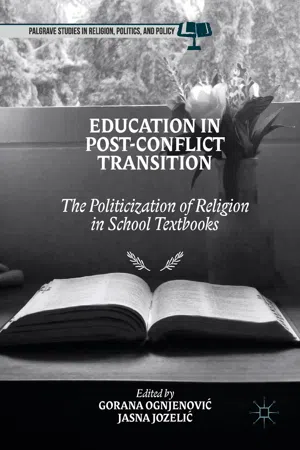Even though the series of wars in former Yugoslavia during the 1990s had been long over, the segregation amongst members of different ethnic groups within and across the borders of successor states has never before appeared greater and more systematic . Societies in a post-conflict transition are vulnerable to political manipulations , which potentially throughout the transition period pull a society back into conflict. Politicization as misuse of freedom of religion is an example of one such manipulation. 1
The politicization of religion 2 had been proven in this context to be one of the most effective mechanisms (as we pointed out in our two first volumes on politicization of religion), by which nationalists traditionally keep ethnic groups separate from each other and in constant coercion with each other, both within and across the borders of the newborn successor states.
The reason why we, in this third volume on politicization of religion, analyze particular samples of school textbooks in primary and secondary schools, as one of the primary cornerstones of educational policy in the Southeast , is quite simple: education in a post-conflict transition is precisely where a society chooses to either progress or regress, to either continue to move in the direction of reconciliation or to regress back into the original conflict or apartheid. In the school textbooks of the Southeast, we can evaluate the states’ intentions through the educational policy to either build a society according to human rights convention or to build a society built on continuous hate and segregation between the groups. 3
There are two reasons why school textbooks for religious education in public schools are interesting as a subject for our systematic analyses. On the one hand, religion or more precisely, the politicization of religion (as we have shown in our first two volumes), was a strong factor in encouraging and accommodating ethnic violence in Southeastern Europe since the 1990s, including genocide . However, it is interesting to remark that the religious curriculum in public schools was not immediately considered as problematic or explanatory for quite some time, as certain other so-called national subjects were (i.e. language , geography and history ). 4 On the other hand, the Yugoslav successor states ever since have also claimed as part of their transition procedure that education has been used as one of the instruments for introducing reconciliation processes only, between ethnic and religious groups .
The reason why analysing early education is of such great importance is that this system concerns children and young people who grew up after the war , and who have no recollection of what life in former Yugoslavia was like, a community without intolerance towards others in contrast to what they experience today. The absence of this particular memory made new generations vulnerable to the cynical political games by the local elite , who got away so many years after the war, with the original plan of dividing the people as never before. Consequently, they managed to forge the history of the Southeast in cooperation with the national secular successor states who until this very date encourage religious conflict as ethnical conflict for the purpose of achieving their (primitive) political gains of ethnic assimilation or ethnic segregation within their national borders.
How is this possible?
In order to find some answers to this question looking into the primary and secondary school curricula of religious education appeared to be a prerequisite for understanding the origins of this systematic segregation , that is, from where does it spring as well as how it is reproduced within educational practice. Our analyses had to go deeper into a multidisciplinary academic research where answers were to be found in the crossroads between educational politics , social psychology, political science, theology and history , including the history of religion , cultural studies, sociology, linguistics, philosophy, anthropology as well as social anthropology and gender studies.
One research question this study does not ask is ‘whether religion is politicized in public school textbooks in the Southeast ’. The research questions this study asks and, hopefully, answers are to what degree religion is politicized in various examples of school textbooks used in public schools and for what purpose.
What also makes this particular study unprecedented is that it deals with two of the three Abrahamic religions , which are considered to be the main religions in the Southeast . As we will see, it is also very interesting considering how both Abrahamic religions (Christianity and Islam) have many overlapping views and a similar understanding of certain issues. For example, their mutual relationship (towards each other) as Abrahamic religions, their relationship to other religions as well as their relationship to the world at large.
There are a number of examples in the history of Yugoslavia , which show how religious institutions even during the Tito’s period acted as political agents when it came to expanding their populous of followers. One of the reasons why this kind of study was not carried out before could be due to the age of its subjects it belongs to the deep dialectics between the private and public (family life parallel to primary and secondary education ): dealing with underage children. This fact has trivialized the depth of seriousness of such an undertaking, since, as Maca Jogan shows 5 it is exactly the institutional protection what makes religious socialization simpler and more effective especially when it comes to one of the primary targets: family as the context wherein people are formed. It is, nevertheless, the easiest within the institution of the family during one’s formative years (the primary, secondary and high school ) to create the impression that religious formation just like childbearing is one of the life’s natural processes. The context of family, in addition, is also a context of the interpretation of women’s bodies as a means to family and therefore religious territory . The political app...
